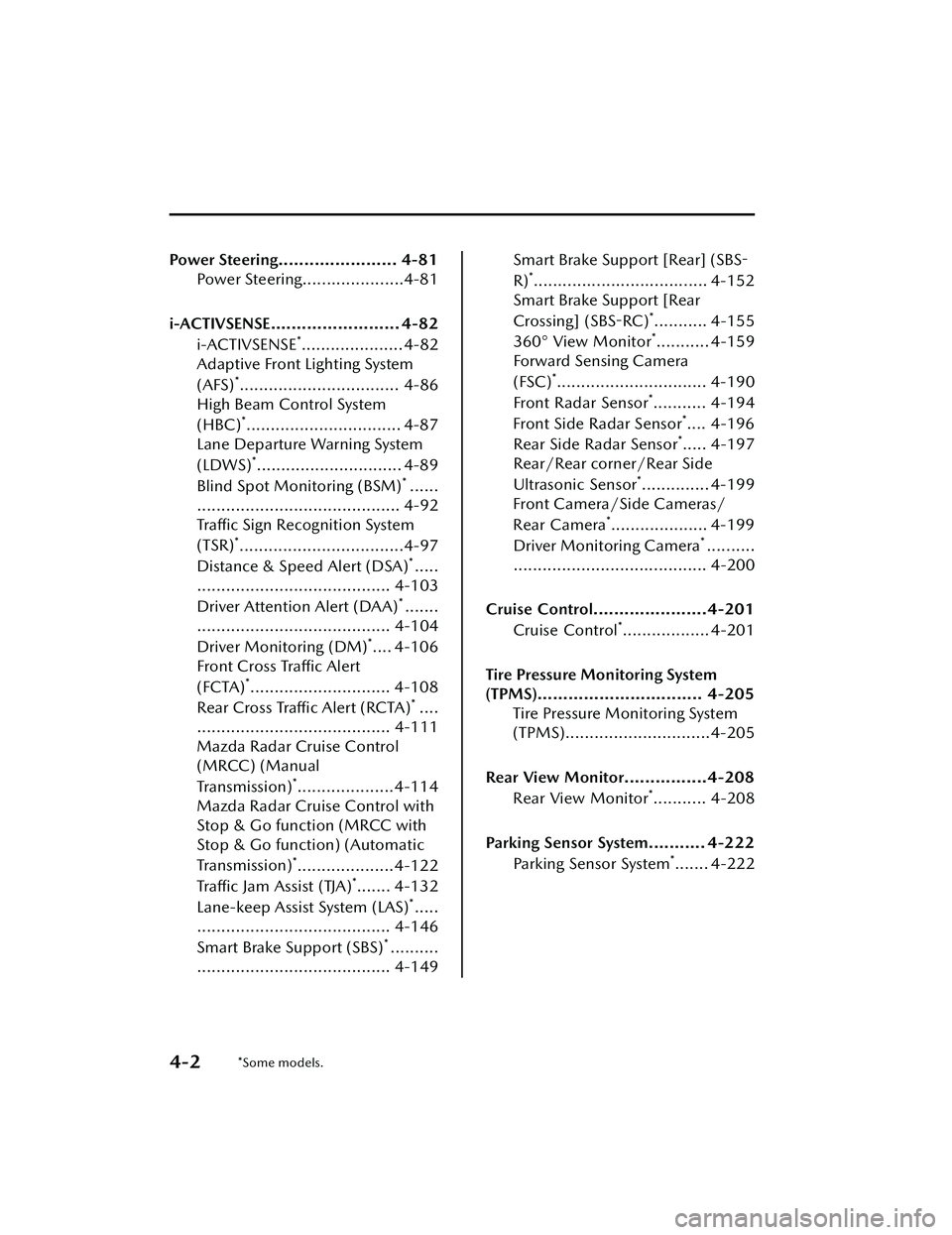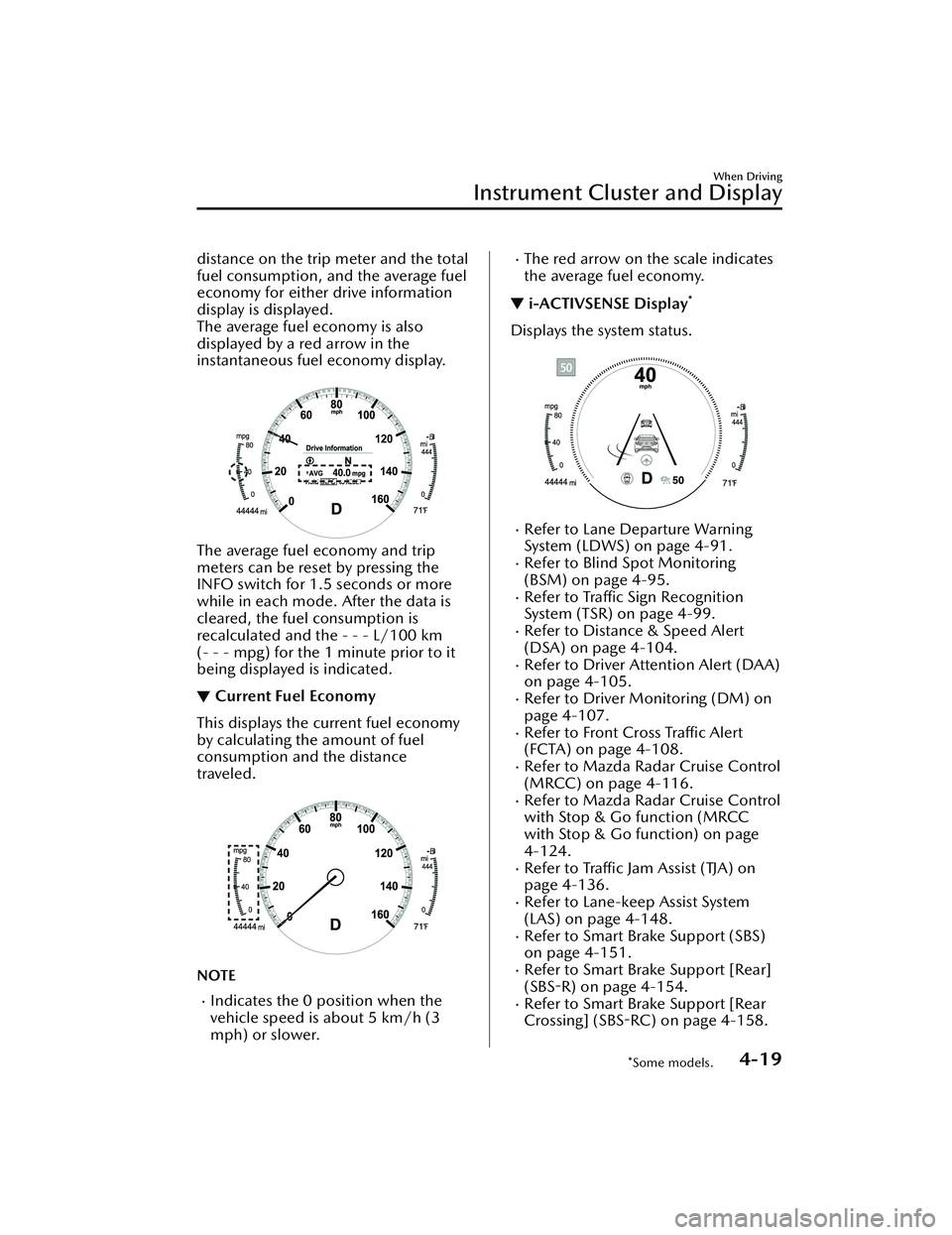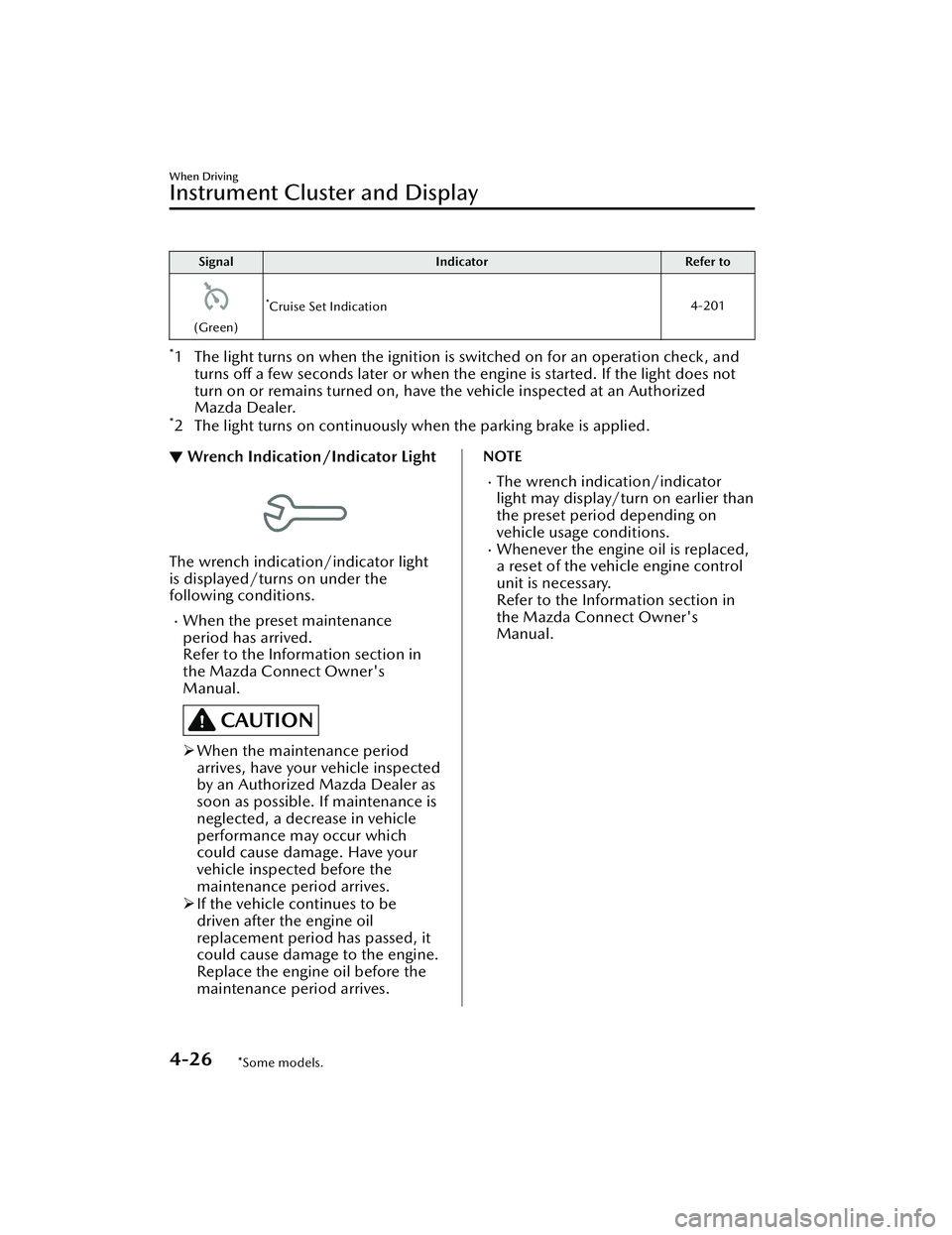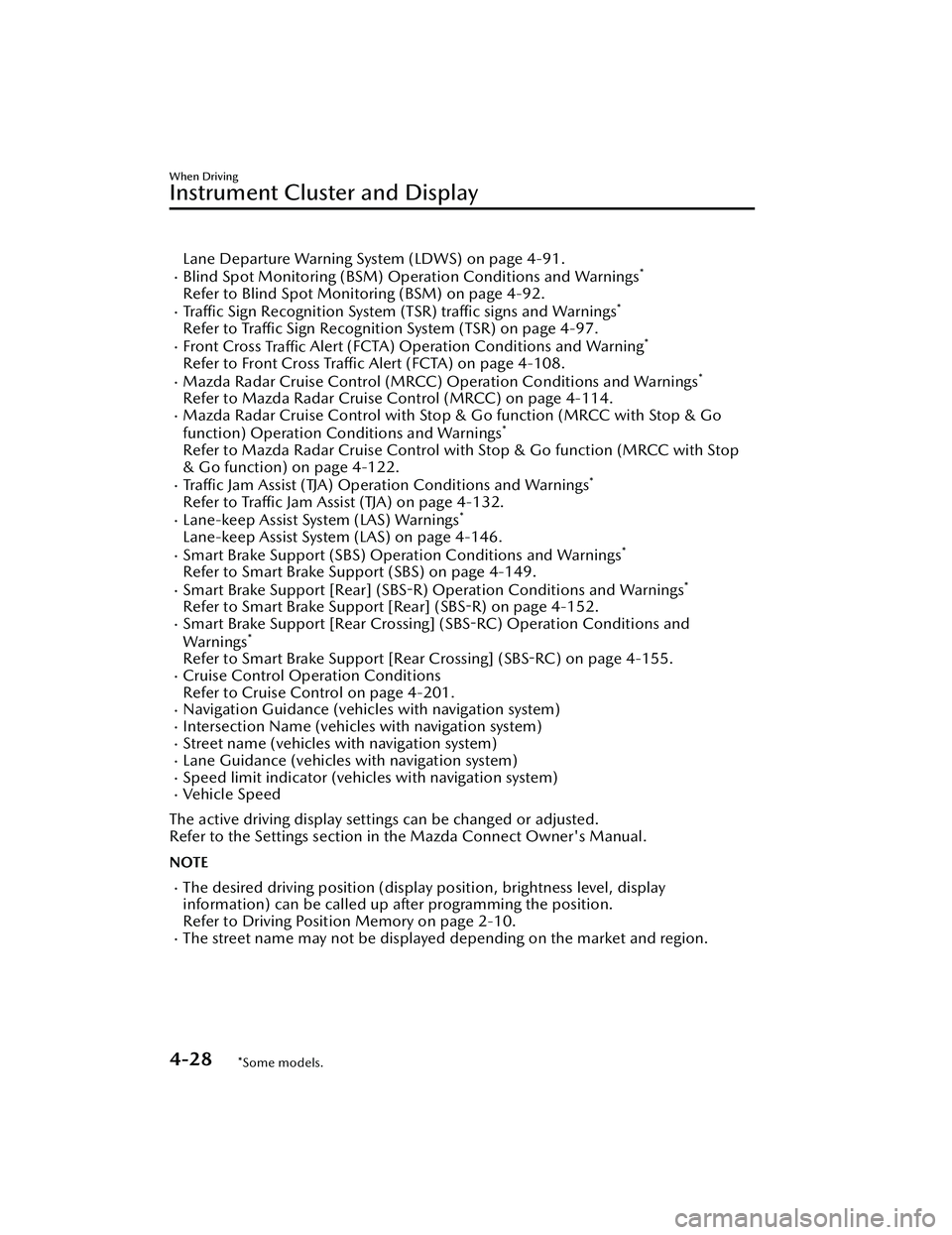ECO mode MAZDA MODEL CX-30 2020 User Guide
[x] Cancel search | Manufacturer: MAZDA, Model Year: 2020, Model line: MODEL CX-30, Model: MAZDA MODEL CX-30 2020Pages: 562, PDF Size: 83 MB
Page 116 of 562

2. Press the select switch for theoutside mirror to be tilted
downward to turn on the indicator
light of the select switch.
3. Shift the shift lever/selector lever to the R position to tilt the outer
mirror on the side where the select
button was pressed downward.
NOTE
When any of the fo llowing condition is
met, the outer mirrors return to their
normal positions.
The ignition is switched to a position
other than ON.
The shift lever/selector lever is
shifted to a position other than R.
The select switch is pressed again.
Folding outside mirror
WARNING
Always return the outside mirrors to
the driving position before you start
driving:
Driving with the outside mirrors folded
in is dangerous. Your rear view will be
restricted, and you could have an
accident.
Manually fold the outside mirror
rearward until it is flush with the
vehicle.
Engine-off outside mirror operation
The outside mirrors can be operated
for about 40 seconds after the ignition
is switched from ON to off.
Driver's side auto-dimming outside
mirror*
The movement of the auto-dimming
outside mirror is interlocked with the
auto-dimming rearview mirror in the
interior to automatically reduce glare
from rear on-coming vehicles.
Refer to Rearview Mirror on page
3-34.
NOTE
The front passenger-side outside
mirror does not have the
auto-dimming feature.
▼ Rearview Mirror
WARNING
Do not stack cargo or objects higher
than the seatbacks:
Cargo stacked higher than the
seatbacks is dangerous. It can block
your view in the rearview mirror, which
might cause you to hit another car
when changing lanes.
Before Driving
Mirrors
3-34*Some models.
CX-30_8HG6-EA-19I_Edition1_new
2019-6-13 18:45:11
Page 122 of 562

Moonroof*
▼Moonroof
The moonroof can be opened or
closed when operating the overhead
tilt/slide switch at the front seats.
WARNING
Do not let passengers stand up or
extend part of the body through the
open moonroof while the vehicle is
moving:
Extending the head, arms, or other
parts of the body through the
moonroof is dangerous. The head or
arms could hit something while the
vehicle is moving. This could cause
serious injury or death.
Never allow children to play with the
tilt/slide switch:
The tilt/slide switch would allow
children to operate the moonroof
unintentionally, which could result in
serious injury if a child's hands, head
or neck becomes caught by the
moonroof.
Make sure the opening is clear before
closing the moonroof:
A closing moonroof is dangerous. The
hands, head, or even neck of a person,
especially a child, could be caught in it
as it closes, causing serious injury or
even death.
Make sure nothing blocks the
moonroof just before it reaches the
fully closed position:
Blocking the moonroof just before it
reaches the closed position is
dangerous.
In this case, the jam-safe function
cannot prevent the moonroof from
closing. If fingers are caught, serious
injuries could occur.
CAUTION
Do not sit on or put heavy items on
the area where the moonroof opens
and closes. Otherwise, the
moonroof could be damaged.
Do not open or close the moonroof
forcefully during freezing
temperatures or snowfall. Otherwise,
the moonroof could be damaged.
The sunshade does not tilt. To avoid
damaging the sunshade, do not push
it up.
Do not close the sunshade while the
moonroof is opening. Trying to force
the sunshade closed could damage
it.
▼ Tilt/Slide Operation
The moonroof can be opened or
closed electrically only when the
ignition is switched ON.
Before leaving the vehicle or washing
your Mazda, make sure the
moonroof is completely closed so
that water does not get inside the
cabin area.
After washing your Mazda or after it
rains, wipe the water off the
moonroof before operating it to
avoid water penetration which could
Before Driving
Windows
3-40*Some models.
CX-30_8HG6-EA-19I_Edition1_new
2019-6-13 18:45:11
Page 127 of 562

Theft-Deterrent System*
▼Theft-Deterrent System
If the theft-deterrent system detects an
inappropriate entry into the vehicle,
which could result in the vehicle or its
contents being stolen, the alarm alerts
the surrounding area of an abnormality
by sounding the horn and flashing the
hazard warning lights.
The system will not function unless it's
properly armed. So when you leave the
vehicle, follow the arming procedure
correctly.
▼Operation
System triggering conditions
The horn sounds intermittently and the
hazard warning ligh
ts flash for about
30 seconds when the system is
triggered by any one of the following:
Unlocking a door with the auxiliary
key, door lock switch, or an inside
door-lock knob.
Forcing open a door, the hood or the
liftgate.
Opening the hood by operating the
hood release handle.
Switching the ignition ON without
using the push button start.
If the system is triggered again, the
lights and horn will activate until the
driver's door or the liftgate is unlocked
with the transmitter.
(With the advanced keyless function)
The lights and horn can also be
deactivated by touching the sensing
area of the door release touch sensor.
NOTE
If the battery goes dead while the
theft-deterrent system is armed, the
horn will activate and the hazard
warning lights will flash when the
battery is charged or replaced.
▼ How to Arm the System
1. Close the windows and the
moonroof* securely.
2. Switch the ignition OFF.
3. Make sure the hood, the doors, and the liftgate are closed.
4. Press the lock button on the transmitter.
The hazard warning lights will flash
once.
The following method will also arm
the theft-deterrent system:
Press the door-lock switch “
”
while any door is open and then
close all of the doors.
(With the advanced keyless
function)
Touch the sensing area of the door
lock touch sensor.
The security indicator light in the
instrument cluster flashes twice per
second for 20 seconds.
5. After 20 seconds, the system is fully armed.
NOTE
The theft-deterrent system can also
be armed by activating the auto
relock function with all the doors,
the liftgate and the hood closed.
Refer to Transmitter on page 3-5.
Before Driving
Security System
*Some models.3-45
CX-30_8HG6-EA-19I_Edition1_new 2019-6-13 18:45:11
Page 138 of 562

Power Steering....................... 4-81Power Steering.....................4-81
i-ACTIVSENSE......................... 4-82 i-ACTIVSENSE
*..................... 4-82
Adaptive Front Lighting System
(AFS)
*................................. 4-86
High Beam Control System
(HBC)
*................................ 4-87
Lane Departure Warning System
(LDWS)
*.............................. 4-89
Blind Spot Monitoring (BSM)
*......
.......................................... 4-92 Traffic Sign Recognition System
(TSR)
*..................................4-97
Distance & Speed Alert (DSA)
*.....
........................................ 4-103
Driver Attention Alert (DAA)
*.......
........................................ 4-104
Driver Monitoring (DM)
*.... 4-106
Front Cross Traffic Alert
(FCTA)
*............................. 4-108
Rear Cross Traffic Alert (RCTA)
*....
........................................ 4-111
Mazda Radar Cruise Control
(MRCC) (Manual
Transmission)
*....................4-114
Mazda Radar Cruise Control with
Stop & Go function (MRCC with
Stop & Go function) (Automatic
Transmission)
*....................4-122
Traffic Jam Assist (TJA)
*....... 4-132
Lane-keep Assist System (LAS)
*.....
........................................ 4-146
Smart Brake Support (SBS)
*..........
........................................ 4-149
Smart Brake Support [Rear] (SBS-
R)
*.................................... 4-152
Smart Brake Support [Rear
Crossing] (SBS-RC)
*........... 4-155
360° View Monitor
*........... 4-159
Forward Sensing Camera
(FSC)
*............................... 4-190
Front Radar Sensor
*........... 4-194
Front Side Radar Sensor
*.... 4-196
Rear Side Radar Sensor
*..... 4-197
Rear/Rear corner/Rear Side
Ultrasonic Sensor
*.............. 4-199
Front Camera/Side Cameras/
Rear Camera
*.................... 4-199
Driver Monitoring Camera
*..........
........................................ 4-200
Cruise Control......................4-201 Cruise Control
*.................. 4-201
Tire Pressure Monitoring System
(TPMS)................................ 4-205 Tire Pressure Monitoring System
(TPMS)..............................4-205
Rear View Monitor................4-208 Rear View Monitor
*........... 4-208
Parking Sensor System........... 4-222 Parking Sensor System
*....... 4-222
4-2*Some models.
CX-30_8HG6-EA-19I_Edition1_new 2019-6-13 18:45:11
Page 146 of 562

Replace with a new battery before
the key becomes unusable.
Refer to Key Battery Replacement on
page 6-26.
A message is indicated in the display
of the instrument cluster.
Refer to KEY Warning Indication/
Warning Light (Red) on page 7-28.
(Automatic transmission)
If the engine is turned off while the
selector lever is in a position other
than P, the ignition switches to ACC.
▼Emergency Engine Stop
Continuously pressing the push button
start or quickly pressing it any number
of times while the engine is running or
the vehicle is being driven will turn the
engine off immediately. The ignition
switches to ACC.
Cylinder Deactivation*
▼ Cylinder Deactivation
The cylinder deactivation is a function
designed to reduce fuel consumption
and improve fuel economy by
deactivating 2 out of the 4 cylinders
while driving. The function constantly
determines which is better for driving;
4 cylinders or 2 cylinders, regardless of
the driver's operations, and it performs
the switching automatically.
When the cylinder deactivation
function does not operate
The cylinder deactivation function
does not operate under the following
conditions.
The selector lever is in the P, N, or R
position (automatic transmission), or
1st gear (manual transmission).
The engine oil temperature or engine
coolant temperature is low.
After disconnecting the battery
terminals for some reason, such as
for battery replacement.
When Driving
Start/Stop Engine
4-10*Some models.
CX-30_8HG6-EA-19I_Edition1_new
2019-6-13 18:45:11
Page 151 of 562

▼Odometer, Trip Meter and Trip
Meter Selector
You can switch between the odometer
and trip meter display using the TRIP
switch.
1. TRIP switch
2. Odometer display
3. Trip meter A display
4. Trip meter B display
Odometer
The odometer records the total
distance the vehicle has been driven.
Tr i p m e t e r
The driving distance for a specified
interval is indicated. Two types (TRIP A,
TRIP B) of interval distance and the
average fuel economy for each can be
measured.
For instance, trip meter A can record
the distance from the point of origin,
and trip meter B can record the
distance from where the fuel tank is
filled.
When trip meter A is selected, TRIP A
will be displayed. When trip meter B is
selected, TRIP B will be displayed.
The trip meter and average fuel
economy can be reset by pressing the
TRIP switch for 1.5 seconds or more
while in each mode.
NOTE
Only the trip meters record tenths of
kilometers (miles).
The trip record will be erased when:
The power supply is interrupted
(blown fuse or the battery is
disconnected).
The vehicle is driven over 9999.9
km (mile).
▼Engine Coolant Temperature
Gauge
Displays the engine coolant
temperature. The blue range of the
gauge indicates that the engine coolant
temperature is low, and the red range
of the gauge indicates that the engine
coolant temperature is high and
overheating.
When Driving
Instrument Cluster and Display
4-15
CX-30_8HG6-EA-19I_Edition1_new
2019-6-13 18:45:11
Page 155 of 562

distance on the trip meter and the total
fuel consumption, and the average fuel
economy for either drive information
display is displayed.
The average fuel economy is also
displayed by a red arrow in the
instantaneous fuel economy display.
The average fuel economy and trip
meters can be reset by pressing the
INFO switch for 1.5 seconds or more
while in each mode. After the data is
cleared, the fuel consumption is
recalculated and the - - - L/100 km
(- - - mpg) for the 1 minute prior to it
being displayed is indicated.
▼Current Fuel Economy
This displays the current fuel economy
by calculating the amount of fuel
consumption and the distance
traveled.
NOTE
Indicates the 0 position when the
vehicle speed is about 5 km/h (3
mph) or slower.
The red arrow on the scale indicates
the average fuel economy.
▼
i-ACTIVSENSE Display*
Displays the system status.
Refer to Lane Departure Warning
System (LDWS) on page 4-91.
Refer to Blind Spot Monitoring
(BSM) on page 4-95.
Refer to Traffic Sign Recognition
System (TSR) on page 4-99.
Refer to Distance & Speed Alert
(DSA) on page 4-104.
Refer to Driver Attention Alert (DAA)
on page 4-105.
Refer to Driver Monitoring (DM) on
page 4-107.
Refer to Front Cross Traffic Alert
(FCTA) on page 4-108.
Refer to Mazda Radar Cruise Control
(MRCC) on page 4-116.
Refer to Mazda Radar Cruise Control
with Stop & Go function (MRCC
with Stop & Go function) on page
4-124.
Refer to
Tra ffi c Jam Assist (TJA) on
page 4-136.
Refer to Lane-keep Assist System
(LAS) on page 4-148.
Refer to Smart Brake Support (SBS)
on page 4-151.
Refer to Smart Brake Support [Rear]
(SBS-R) on page 4-154.
Refer to Smart Brake Support [Rear
Crossing] (SBS-RC) on page 4-158.
When Driving
Instrument Cluster and Display
*Some models.4-19
CX-30_8HG6-EA-19I_Edition1_new
2019-6-13 18:45:11
Page 159 of 562

SignalWarning Refer to
Door-Ajar Warning Light 7-31
*1 The light turns on when the ignition is switched on for an operation check, and turns off a few
seconds later or when the engine is started. If the light does not turn on or remains turned on, have
the vehicle inspected at an Authorized Mazda Dealer.
▼Indication/Indicator Lights
These lights turn on or flash to notify th
e user of the system operation status or a
system malfunction.
Signal Indicator Refer to
(Green)Seat Belt Indicator Light (Rear seat)
2-24
*Front Passenger Air Bag Deactivation Indicator Light2-64
Security Indicator Light
3-44
(Green)KEY Indicator Light
4-5
Wrench Indication/Indicator Light*14-26
*Shift Position Indication4-34
Lights-On Indicator Light
4-42
Headlight High-Beam Indicator LightHeadlight
High-Low
Beam4-45
Flashing the Headlights
4-45
When Driving
Instrument Cluster and Display
*Some models.4-23
CX-30_8HG6-EA-19I_Edition1_new 2019-6-13 18:45:11
Page 162 of 562

SignalIndicator Refer to
(Green)
*Cruise Set Indication 4-201
*1 The light turns on when the ignition is switched on for an operation check, and
turns off a few seconds later or when the engine is started. If the light does not
turn on or remains turned on, have the vehicle inspected at an Authorized
Mazda Dealer.
*2 The light turns on continuously when the parking brake is applied.
▼ Wrench Indication/Indicator Light
The wrench indication/indicator light
is displayed/turns on under the
following conditions.
When the preset maintenance
period has arrived.
Refer to the Information section in
the Mazda Connect Owner's
Manual.
CAUTION
When the maintenance period
arrives, have your vehicle inspected
by an Authorized Mazda Dealer as
soon as possible. If maintenance is
neglected, a decrease in vehicle
performance may occur which
could cause damage. Have your
vehicle inspected before the
maintenance pe riod arrives.
If the vehicle continues to be
driven after the engine oil
replacement period has passed, it
could cause damage to the engine.
Replace the engine oil before the
maintenance pe riod arrives.
NOTE
The wrench indication/indicator
light may display/turn on earlier than
the preset period depending on
vehicle usage conditions.
Whenever the engine oil is replaced,
a reset of the vehicle engine control
unit is necessary.
Refer to the Information section in
the Mazda Connect Owner's
Manual.
When Driving
Instrument Cluster and Display
4-26*Some models.
CX-30_8HG6-EA-19I_Edition1_new 2019-6-13 18:45:11
Page 164 of 562

Lane Departure Warning System (LDWS) on page 4-91.Blind Spot Monitoring (BSM) Operation Conditions and Warnings*
Refer to Blind Spot Monitoring (BSM) on page 4-92.Traffic Sign Recognition System (TSR) traffic signs and Warnings*
Refer to Traffic Sign Recognition System (TSR) on page 4-97.Front Cross
Tra ffi c Alert (FCTA) Operation Conditions and Warning*
Refer to Front Cross Traffic Al
ert (FCTA) on page 4-108.Mazda Radar Cruise Control (MRCC) Operation Conditions and Warnings*
Refer to Mazda Radar Cruise Control (MRCC) on page 4-114.Mazda Radar Cruise Control with Stop & Go function (MRCC with Stop & Go
function) Operation Conditions and Warnings*
Refer to Mazda Radar Cruise Control with Stop & Go function (MRCC with Stop
& Go function) on page 4-122.
Traffic Jam Assist (TJA) Operation Conditions and Warnings*
Refer to Traffic Jam Assist (TJA) on page 4-132.Lane-keep Assist System (LAS) Warnings*
Lane-keep Assist System (LAS) on page 4-146.Smart Brake Support (SBS) Operation Conditions and Warnings*
Refer to Smart Brake Support (SBS) on page 4-149.Smart Brake Support [Rear] (SBS-R) Operation Conditions and Warnings*
Refer to Smart Brake Support [Rear] (SBS-R) on page 4-152.Smart Brake Support [Rear Crossing]
(SBS-RC) Operation Conditions and
Warnings*
Refer to Smart Brake Support [Rear Crossing] (SBS-RC) on page 4-155.Cruise Control Operation Conditions
Refer to Cruise Control on page 4-201.
Navigation Guidance (vehicles with navigation system)Intersection Name (vehicles with navigation system)Street name (vehicles with navigation system)Lane Guidance (vehicles with navigation system)Speed limit indicator (vehicles with navigation system)Vehicle Speed
The active driving display settin gs can be changed or adjusted.
Refer to the Settings section in the Mazda Connect Owner's Manual.
NOTE
The desired driving position (display position, brightness level, display
information) can be called up after programming the position.
Refer to Driving Position Memory on page 2-10.
The street name may not be displayed depending on the market and region.
When Driving
Instrument Cluster and Display
4-28*Some models.
CX-30_8HG6-EA-19I_Edition1_new 2019-6-13 18:45:11